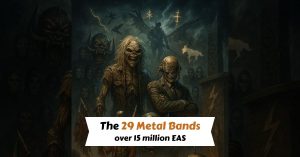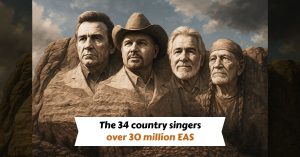Best-selling albums in the Netherlands in the 90s
The 90s! A time when Westerners thought the end of history was near: the end of the Cold War, continued economic growth, peace talks in the Middle East, the development of the internet, and superstar divas! Today we go back to this decade to wonder which albums were the best-selling ones? Not worldwide. Instead, we’re going to give you an insight of the best-selling albums and albums artists in the 90s in the Netherlands.
Why the Dutch 90s?
For chart and accuracy lovers, the 1990-99 decade is an important one. It saw the height of pure album sales as well as expansion, through globalization, of western music to all parts of the world (starting in the 80s of course with Michael Jackson and Madonna‘s efforts).
The Dutch example is particularly interesting for two reasons. First, it was the first decade that saw Year End Charts based solely on sales (from 1994 onwards). Second, it was the latest decade with no Decade End Chart based on sales. In the 21st century, all decades have End Charts based on sales, these days with streaming included, of course.
Moreover, it’s also the last decade with (the Dutch all-time highest) certification levels of 50.000 album sales (Gold) and 100.000 (Platinum). In 1999, the bars were lowered to 40.000 and 80.000 respectively, and continued to decrease, reaching 20.000/40.000 (streaming included) in the present day.
Looking back at the Dutch 90’s
Nowadays, when Dutch music-lovers look back to the 90s and think of the best music, they, depending on the radio station asking the question, think about very different artists. For example, they mention rock artists (Black by Pearl Jam, Thunderstruck by AC/DC, Nirvana‘s Smells Like Teen Spirit or November Rain by Guns N’ Roses).
Happy hardcore DJ’s (Rainbow in the Sky by DJ Paul Elstak, Wonderfull Days by Charly Lownoise & Mental Theo or No Limit by 2 Unlimited) and Angels by Robbie Williams are mentioned as well. But were these artists, or their respective albums, really the best sellers of their age? We’re going to find out, but here’s a little hint beforehand: no.
Diva Domination
Globalization certainly struck hard in the Netherlands in the 90s. Especially the so-called ‘Big Four Divas’ were most able to ride the marketing waves. Celine Dion was the biggest of them, with four #1 albums with a total of 26 weeks #1. This included 12 weeks by Falling Into You, the best-selling album of 1996 in the Netherlands. Her total album sales, fuelled by 2 major #1 hits Think Twice and My Heart Will Go On, approach 2 million in the 90s only. Even her French-language album D’eux managed 2 weeks at the top.
Mariah Carey is not far behind, however, also having a quartet of #1 albums (and 2 #1 singles: I’ll Be There and Without You). She spent 18 weeks at #1 in the album charts. Two-thirds of those weeks were achieved by Music Box, easily becoming 1994’s no 1 selling album in the Netherlands. Her 90s album sales surpassed 1.5 million.
Both Madonna and Whitney Houston, having already peaked in the 80s, added almost a million albums to their totals in the latest decade of the 20th century.
Other international best-sellers
Besides these ladies, the omnipresent Michael Jackson and Queen couldn’t be ignored either. Already hugely successful before, they hardly slowed down after 1990. Jackson added two #1 albums (4 weeks #1), while Queen even managed to get one more (16 weeks in total). They sold about 1 million and 1.5 million albums, respectively.
Phil Collins and Eros Ramazzotti also rounded the milestone of 1 million. The British singer and drummer, huge in the 80s, did so with decreasing album sales. His Italian counterpart continued to sell decent amounts of albums during the whole decade. Bubbling under (0,5 – 1 million) were mostly European acts: George Michael, Eric Clapton, U2 and Andrea Bocelli, as well as the Guns N’ Roses and Bon Jovi.
Dutch acts
But the countermovement of homegrown acts had its impact as well, especially from 1994 onwards. That’s when Marco Borsato, Italian-Dutch singer presently compromised by accusations of sexual harassment, started releasing music in the Dutch language. He went on to sell over 2 million copies of his four Dutch 90s albums. In the meantime, Borsato grabbed the title of best selling album of the year in 1997 and 1998. Moreover, he became the most successful artist in the 90s.
Borsato is above the likes of Paul de Leeuw, Frans Bauer (both north of 1 million album sales), and Guus Meeuwis, whose single succes outdid his Platinum-selling debut album. Later in the decade, Total Touch, Anouk and Ilse DeLange, who all had one massive 90s album with English lyrics, followed suit. Besides these, golden oldies of BZN were able to achieve Platinum-selling albums virtually every year of the decade.
Surprising top-sellers
But which albums sold the most? Most (17) of the artists who made the top 20 are already mentioned. Of the other 3, Supertramp and Toto sold many copies of their respective compilations of 70s and 80s material. They deserve a place amongst the biggest 90s stars in the Netherlands.
The winner of best-selling album of the 90s however, is a somewhat surprising name. One that is actually internationally successful to this very day: André Rieu.
His Strauss & Co is not a pop album, but dominated the album charts for a staggering 19 weeks. It became the best-selling album of 1995 and the best-selling album for the 90s. Rieu sold nearly 1.5 million albums of his classical renditions during the decade, with more than half coming from his 1994 blockbuster.
Top 20 best-selling albums of the Netherlands in the 90s
| No | Artist – album | Est. sales |
| 1 | André Rieu – Strauss & Co | 810.000 |
| 2 | Marco Borsato – De Waarheid | 710.000 |
| 3 | Mariah Carey – Music Box | 660.000 |
| 4 | Céline Dion – Falling Into You | 620.000 |
| 5 | Marco Borsato – Als Geen Ander | 600.000 |
| 6 | Soundtrack – The Bodyguard | 575.000 |
| 7 | Marco Borsato – De Bestemming | 570.000 |
| 8 | Céline Dion – Let’s Talk About Love | 525.000 |
| 9 | Queen – Greatest Hits II | 520.000 |
| 10 | Eric Clapton – Unplugged | 475.000 |
| 11 | Toto – Past to Present 1977-1990 | 420.000 |
| 12 | Total Touch – Total Touch | 415.000 |
| 13 | Paul de Leeuw – Plugged | 410.000 |
| 14 | Marco Borsato – Marco | 395.000 |
| 15 | Phil Collins – …but Seriously | 390.000 |
| 16 | Michael Jackson – Dangerous | 385.000 |
| 17 | Andrea Bocelli – Romanza | 380.000 |
| 18 | Anouk – Together Alone | 380.000 |
| 19 | Phil Collins – Serious Hits….Live! | 375.000 |
| 20 | Supertramp – The Very Best of | 360.000 |
Given the overwhelming presence of international music in the Netherlands, the numerous appearances of homegrown talents in this top 20 looks surprising. It’s similar to the multiple monster selling country music albums in the US. Marco Borsato‘s dominance is incredible with albums charting at 2, 5, 7, and 14.
While most international artists are very familiar, the absence of major contemporary rock acts, like Metallica (US) or Oasis (UK), is most striking. But this was also the case in France, Sweden and Germany, among other countries. The difference between looking back at the 90s and the actual 90s sales is huge, but not only in the Netherlands. It appears that rock music as a whole, and not only the evergreen 60s classic rock, has the ability to last longer than its pop counterpart.
We have more for you…
… articles about best-sellers
… sales rankings
Artists
360° analytics – Best-Selling Artists | by Decade
Tools: Artist Dashboard | Artists Comparator
Streaming deep dive – Most-Streamed Artists
Tools: Playcounts | Royalties | Global Reach | Stats History
Other KPIs – Monthly listeners | Followers | Top money makers







